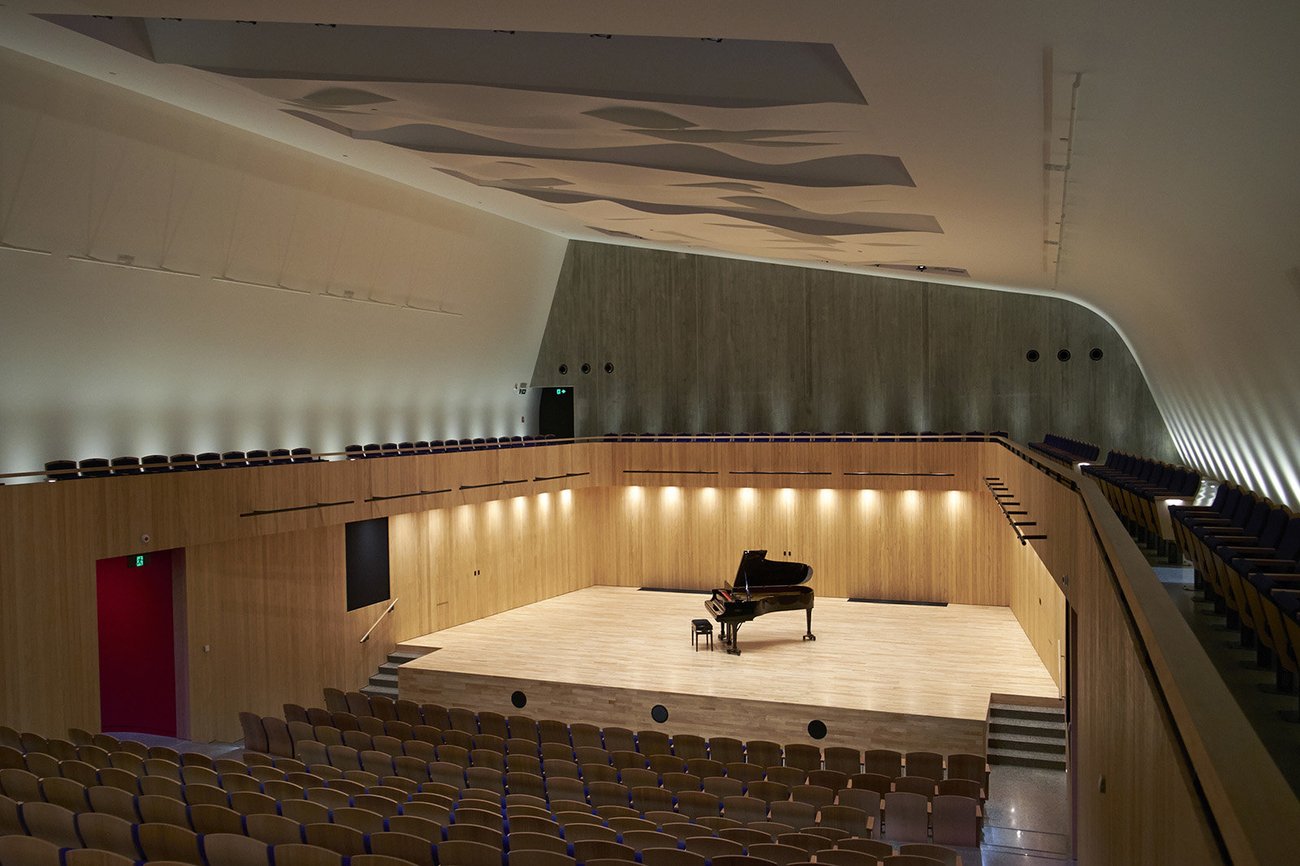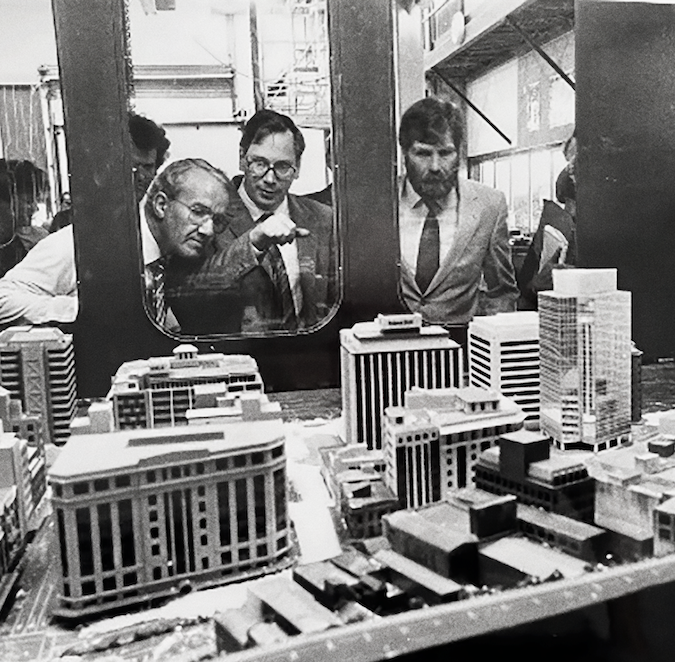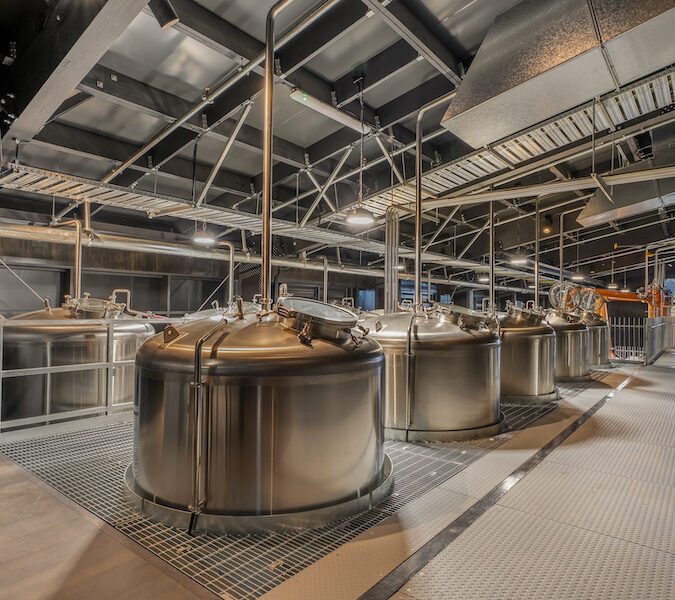
This year’s awards saw the introduction of three new categories – the John Scott Award for public architecture, the Sir Ian Athfield Award for housing, and the Sir Miles Warren Award for commercial architecture.
Awards jury convenor, Auckland architect Pete Bossley, said the process of shortlisting was a difficult one.
“The tough calls began on day one of shortlisting and continued to the very end,” Bossley said. “It has been a strong year in New Zealand architecture, and the buildings we saw amazed and enticed us. It was a privilege to visit them, and a challenge to judge them.”
The jurors described the Blyth Performing Arts Centre, which won a New Zealand Architecture Awards in the education category as well as the New Zealand Architecture Medal, as a “beautifully planned and executed building in which technical as well as architectural issues have been resolved masterfully.”
“On this project, client and architects reached for the sublime – and they got there”.
All the winners, and judges’ comments, are as follows.
New Zealand Architecture Medal
The Blyth Performing Arts Centre – Stevens Lawson Architects
{% gallery ‘blyth’ %}
The jurors described the Blyth Performing Arts Centre as a “beautifully planned and executed building in which technical as well as architectural issues have been resolved masterfully.”
“On this project, client and architects reached for the sublime – and they got there,” the Awards jury said.
John Scott Award (for Public Architecture)
Christchurch Botanic Gardens Visitor Centre – Patterson Associates

Christchurch Botanic Gardens Visitor Centre, the winner of the John Scott Award for Public Architecture, is, the jury said, “an exhilarating contemporary take on the traditional garden greenhouse and an adroit and sympathetic piece of place-making.”
“The elegant form is an inspiring contribution to the public realm in Christchurch,” the jury said.
Sir Miles Warren Award (for Commercial Architecture)
Stranges and Glendenning Hill Building – Sheppard & Rout Architects

“Client and architect set out to make a cosmopolitan, industrious and joyful place on a prominent urban site, and they have succeeded admirably,” the jury said. “With its interior courtyard offering sanctuary from traffic and street noise the building is a modern village with an urbane disposition.”
Sir Ian Athfield Award (for Housing)
Lyttelton Studio Retreat – Bull O’Sullivan Architecture

“This building is a labour of love and a testament to the design capacity, bloody-minded commitment and appetite for sheer hard work of its architect,” the jury said. With a nod to architect Michael O’Sullivan’s ancestry, the jury said the building, “with its robust and straightforward shell and finely crafted interior, perfectly expresses the dichotomy of pugnacity and poetry of a Hibernian heritage.”
Mackelvie Street Shopping Precinct – RTA Studio
Commercial Architecture category

“New laneways and a series of small courtyards open up the precinct to pedestrian passage and commercial use,” the jury noted. “This nicely scaled, well proportioned and appropriately ornamental little retail complex is a charming addition to its character neighbourhood.”
Avondale College – Jasmax
Education category

The multi-stage redevelopment of the large secondary school “has produced an outstanding new learning environment,” the jury said. “This is a school for kids – busy and purposeful, but never regimented or patronising.”
The jury commended the commitment of the Avondale College Board in delivering outstanding new school buildings that exceed standard Ministry of Education provisions.
Iona College Information Resource Centre – Stevens Lawson Architects
Education category

“This elegant building successfully facilitates a teaching transformation, and establishes a collegial relationship with the existing architecture of a century-old girls’ school,” the jury said. “Materials are robust and not at all extravagant, but they are deployed to sophisticated effect in this warm and welcoming building.”
MIT Manukau & Transport Interchange – Warren and Mahoney Architects
Education category

“This impressive building significantly advances two important agendas – access to tertiary education and public transport in South Auckland,” the jury said. “The architects did well in overcoming construction challenges and financial obstacles that could have derailed the whole project.”
The Awards’ enduring architecture category acknowledged buildings that have proved their worth for at least twenty-five years. Four enduring awards were made, two of them in Auckland.
Lopdell House – Mitchell & Stout Architects
Heritage category

Lopdell House in Titirangi has been “remarkably transformed by Mitchell & Stout Architects through an intelligent restorative process,” the jury said. “The building occupies a significant site on the border between suburbia and the bush – it is heartening that it has received architectural attention worthy of its status.”
The Treasury Research Centre & Archive – Architectus
Heritage category

Thames is a welcome presence on the Architecture Awards roster, the town’s Treasury Research Centre & Archive having received an award in the heritage category. Architectus was praised by the jury for its “careful restoration of the Thames Carnegie Library and the provision of a nicely scaled extension.”
Coleraine House (1980) – Athfield Architects
Enduring Architecture category

Coleraine House, formerly Buck House, near Havelock North, is one of the most celebrated buildings designed by the late Sir Ian Athfield. “Icon is an overused word, but there really are few more iconic sights in New Zealand architecture than Coleraine House sitting bright among rows of vines on the slopes of Te Mata Peak,” the jury said. “Valued and cared for, it stands as a testament to a great architectural talent.”
Gibbs House (1984) – Manning Mitchell Architects
Enduring Architecture category

“This house has aged gracefully, retaining a sense of levity and the capacity to surprise and delight,” the jury said. “It is one of the great New Zealand houses of the past forty years, and it is good to see that it is much appreciated by its current owners.”
Deanwell School (1968) – South Auckland Education Board-Architectural Division
Enduring Architecture category

The final award in the enduring architecture category went to Deanwell School in Hamilton, which was designed in the late 1960s by the South Auckland Education Board’s Architectural Division. “This pioneering project which introduced open planning to New Zealand schools was just as radical in its employment of modular design and construction methods,” the jury said.
“The school has lasted well, and its architects must smile when they read about the current back-to-the-future return to open-plan teaching.”
Monica Loves – C Nott Architects
Hospitality & Retail category

Napier, too, is host to a 2015 Architecture Awards winner, in the hospitality and retail category. Monica Loves, designed by C Nott Architects, is “a lively little bar with an industrial chic aesthetic and relaxed ambience,” the jury said. “But it’s so much more than that. It’s a clever bit of city-making that introduces laneway life to Napier.”
Boatsheds – Strachan Group Architects and Rachael Rush in association
Housing category

Boatsheds, a house in Takapuna designed by SGA-Strachan Group Architects and Rachael Rush, is a building “infused with life and spirit that perfectly suits its owners and also makes a generous and significant contribution to its neighbouring context,” the jury said. “It’s a sailing family’s hands-on home in which the impressive operational technology can be tweaked and tuned to keep things on an optimal course.”
Castle Rock House – Herbst Architects
Housing category

The Castle Rock House at Whangarei Heads, designed by Herbst Architects, is “sited beautifully above a beach and below a mountain and next to a mature pohutukawa”.
“In this project, the bach type has been pulled apart and expertly reconstructed as a summer encampment, that most historically resonant form on New Zealand’s north-eastern coast.”
In-Situ House – Stevens Lawson Architects
Housing category

Stevens Lawson Architects won their third 2015 Architecture Award for In-Situ House in Remuera, described by the jury as “a stunning expression of a single-minded and very well-resourced commitment to uncompromising quality. There is a depth and stillness to the house, and a sense of calmness that is testament to the masterful control exhibited in its design and construction.”
Ostend Road Home – Bull O’Sullivan Architecture
Housing category

Waiheke Island is the site of Bull O’Sullivan Architecture’s Award-winning Ostend Road Home. “Crafted rather than merely built, the house is an entirely suitable and very enjoyable home for the young family for whom it was designed,” the jury said.
Red House – Crosson Clarke Carnachan Architects (Auckland)
Housing category

In Titirangi, the Red House, designed by Crosson Clarke Carnachan Architects (Auckland) is “wonderfully connected to its environment,” the jury said. “From its various levels you could safely swear that you can see the trees, the whole trees, and nothing but the trees.”
Clevedon Estate – Herbst Architects
Housing – Alterations & Additions category

“A house sitting on top of a hill has become the heart of an artfully composed rural estate in this adroit exercise in site-making,” the jury said. “The architects have exhibited a sure and light touch and one can sense the pleasure they took in the selection and deployment of materials.”
Sod the Villa – Malcolm Walker Architects
Housing – Alterations & Additions category

The Awards jury said that Malcolm Walker Architects’ reworking of a Grey Lynn villa “has produced a corker of a house.” As might be expected from the name given to the project – Sod the Villa – “there’s a levity and playfulness to this house, perfectly in keeping with the wit and generosity of the clients, and also expressive of the confident spatial mastery of the architect.”
Clyde Quay Wharf Apartment Redevelopment – Athfield Architects
Housing Multi-Unit category

Clyde Quay Wharf Apartment Redevelopment, designed by Athfield Architects, is “a strong addition to the urban shoreline,” the jury said. “Viewed from the harbour the building establishes a nice connection with yachts moored in front of it and houses stepping up Mt Vic behind it.”
Marshall Court Apartments for City Housing WCC – Designgroup Stapleton Elliott
Housing – Multi-Unit category

In giving an award to the Marshall Court Apartments for City Housing WCC in Miramar, the jury noted that “social housing is a tough architectural genre.” Designgroup Stapleton Elliott and the client “worked hard to produce safe and suitable pensioner housing, and in the face of the usual budgetary constrictions, they have succeeded admirably.”
New Zealand China Concept Store – Patterson Associates
International category

The New Zealand China Concept Store in Shanghai, designed by Patterson Associates, is “intentionally a show-off building,” the jury said. “It exhibits its intentions and its contents with clarity and to a thoroughly international standard.”
Kathleen Kilgour Centre – Wingate + Farquhar
Public Architecture category

The Kathleen Kilgour Centre in Tauranga, designed by Wingate + Farquhar, was described as “impressively focused on and sympathetic to the needs of radiotherapy patients undergoing their demanding treatment. All aspects of the project are well considered.”
Te Uru Waitakere Contemporary Gallery – Mitchell & Stout Architects
Public Architecture category

Titirangi’s Te Uru Waitakere Contemporary Gallery, designed by Mitchell & Stout Architects, received an award in the public architecture category. The new gallery is “a tour de force,” the jury said. “A lot of architecture has been squeezed out of a modest budget.”
Te Kaitaka – ‘The Cloak’ – Fearon Hay Architects
Small Project Architecture category

The first winner of the Small Projects category was Te Kaitaka -The Cloak, a building in the Auckland Airport commercial precinct designed by Fearon Hay Architects. “The low, mound-like building is literally a landmark,” the jury said. “Topped by tufts of grass and partially wrapped in mesh cloak, it is an arresting and intriguing object on its corner site.”
Brooklands Lagoon Public Toilet – Opus Architecture
Small Project Architecture category

The other winner in the Small Projects category was Brooklands Lagoon Public Toilet, designed by Opus Architecture. “What could have been a utilitarian ablution block has been sculpted poetically into a sensitive expression of historical and cultural references.”
The jury noted the building at the mouth of the Styx River was the first stage of a development intended to include a visitor centre. “It would be good to see the project completed,” the jury said. “This fine little building deserves some company.”




